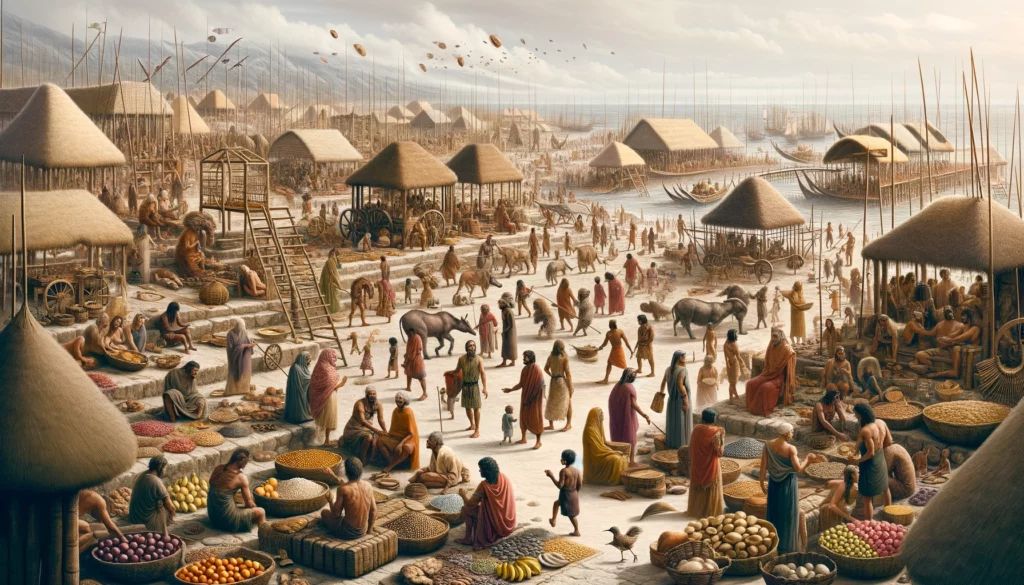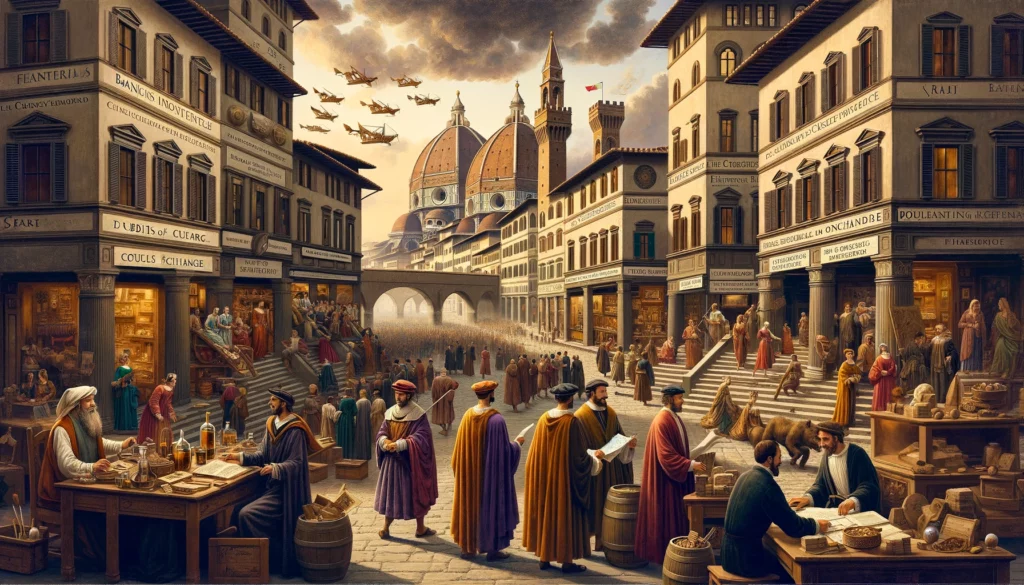Imagine standing at the dawn of human civilization, witnessing the first-ever financial transaction.
Fast forward through centuries of innovation, conflict, and discovery, and you find yourself in the present day — a world where artificial intelligence shapes our financial decisions.
This journey, from the barter systems of early human societies to the AI-powered finance of the 21st century, is not just a story of numbers and transactions but of human progress and the unending quest for better solutions.
Join us as we embark on a voyage through the historical timeline of finance, exploring each era’s unique contributions to the financial world we know today.
The Dawn of Finance: Barter and Early Currency (Pre-600 BCE)

In the beginning, there was barter. Goods were exchanged for goods, and value was a matter of negotiation. However, as societies grew, the limitations of barter became clear. Enter the dawn of currency — from livestock to shells, and eventually to metal coins. This era set the foundation for the concept of ‘money’ as a medium of exchange, a store of value, and a unit of account.
Classical Antiquity: Coins and Banking (600 BCE – 500 CE)

The invention of coinage in ancient Lydia (now Turkey) revolutionized trade, enabling more precise value exchange and fostering economic growth. Banking emerged in ancient Greece and Rome, with institutions accepting deposits, making loans, and even exchanging currency. This period laid the groundwork for modern financial systems, emphasizing the importance of trust and standardized currency in economic transactions.
The Middle Ages: Letters of Credit and the Rise of Bonds (500 CE – 1500 CE)

As trade routes expanded, carrying large amounts of coins became impractical and dangerous.
The solution? Letters of credit. This innovation, alongside the introduction of government and corporate bonds in medieval Italy, signaled a shift towards more sophisticated financial instruments, facilitating larger-scale trade and investment projects.
The Renaissance: The Birth of Modern Finance (14th – 17th Century)

Imagine walking through the bustling streets of Florence in the 14th century, amid the fervor of the Renaissance. This era wasn’t just a rebirth of art and culture but also marked the early dawn of modern finance.
The Medici family, renowned as patrons of the arts, were also pioneers in the banking world. Their innovative practices, such as double-entry bookkeeping, laid the groundwork for the financial systems we rely on today. This period saw the rise of bills of exchange as a precursor to modern checks, enabling traders to conduct business across great distances without the perilous transport of coinage.
The Renaissance also witnessed the formation of the first public debt. As governments began to borrow money to fund exploration and wars, they issued bonds to the public, promising repayment with interest. This system financed ventures like Columbus’s voyage to the Americas and laid the foundations for the public finance systems that underpin modern economies.
The Digital Age: Technology Transforms Finance (Late 20th Century)

Expanding Influence: Global Trade and Financial Innovation. As European explorers charted new territories, they established trade routes connecting the East and West. This global trade network necessitated even more complex financial systems, leading to the development of various financial instruments. Insurance, initially conceived to mitigate the risks of maritime voyages, evolved into a sophisticated market that underwrites risks across the economy.
Fast forward to the late 20th century, and the world looks entirely different. The advent of computers and the internet ushered in the Digital Age, revolutionizing how we think about and interact with finance.
The introduction of electronic trading platforms in the 1970s and 1980s, such as NASDAQ, transformed the stock market by vastly increasing trading speed and efficiency. This era democratized access to financial markets, enabling more individuals to invest and trade from anywhere in the world.
The Rise of Personal Finance

Technology also transformed personal finance. The introduction of the ATM in the 1960s provided unprecedented access to cash, while the proliferation of credit cards made credit widely available, changing consumer behavior.
Online banking, which emerged in the 1990s, further empowered individuals to manage their finances digitally, laying the groundwork for the fintech revolution.
The Present and Future: AI-Powered Finance

Today, we’re witnessing a seismic shift in finance, driven by artificial intelligence. AI and machine learning algorithms are now powering everything from credit risk assessment to fraud detection and automated financial advice (robo-advisors). These technologies are making finance smarter, faster, and more personalized, with algorithms analyzing vast amounts of data to make predictions and decisions in real time.
Ethical Considerations and the Path Forward

As we embrace the possibilities of AI in finance, we also face new ethical and regulatory challenges. The potential for algorithmic bias, privacy concerns, and the need for transparency in AI decision-making processes are critical issues that need addressing. As we navigate these challenges, the goal is to harness AI’s power to create a more inclusive, efficient, and resilient financial system.
Reflecting on the Journey and Embracing the Future
The historical timeline of finance is a mirror reflecting humanity’s journey from the simplicity of barter to the complexity of AI-driven markets. Each era’s innovations built upon the last, propelling us forward to new possibilities.
As we stand on the brink of further advancements in AI and finance, we’re reminded of our journey’s continuity and the endless potential for innovation. The future of finance is bright, and as we move forward, we carry the lessons of history with us, ensuring that we create a financial world that benefits all of society.
All the images in this blog are AI-created.


